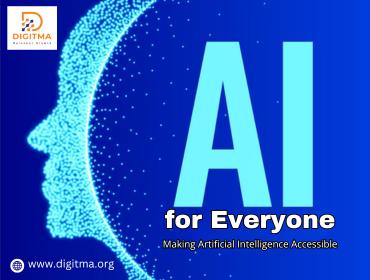
Introduction
Artificial Intelligence (AI) is no longer just something from science fiction movies. It is here, and it is changing the way we live, work, and communicate. But what exactly is AI? Why should you care about it? the best part is—you don’t have to be a tech expert to understand it. AI is for everyone! Whether you’re a student, a professional, a business owner, or just someone curious about the future, AI plays a role in your life.
At its core, AI refers to machines or computers that can perform tasks that usually require human intelligence. These tasks include learning, problem-solving, understanding language, and recognizing images or speech. You may not realize it, but AI is already a part of your daily routine. For example, when you ask Siri or Alexa a question, when Netflix suggests a movie, or when Google helps you complete a sentence, AI is at work.

Types of AI
AI is divided into two main types:
- Narrow AI – This type of AI is designed for specific tasks, like filtering spam emails or detecting fraud in banking. It is the most common form of AI today.
- General AI – This is a more advanced form of AI that can think and learn like a human. It is still mostly theoretical, but researchers are working towards making it a reality.
How AI Works
AI works by using algorithms, which are sets of instructions that help machines process information and make decisions. A key part of AI is Machine Learning (ML). ML allows computers to learn from data and improve over time. For instance, an AI system can learn to recognize dogs in pictures by analyzing thousands of dog images.
AI isn’t just about making life easier—it’s about possibilities. Doctors use AI to diagnose diseases more accurately. Farmers use AI to grow crops more efficiently. Artists use AI to create stunning paintings. The best part? You don’t need to be a scientist to benefit from AI. Anyone can use AI tools to solve problems, automate tasks, or even have fun.
A Brief History of AI
AI has been around longer than you might think. Here are some key moments in its history:
1. The Turing Test (1950)
British mathematician Alan Turing proposed a test to see if a machine could behave like a human. This was one of the first major steps in AI research.
2. The Dartmouth Conference (1956)
This was the event where the term “Artificial Intelligence” was first used. Scientists at this conference believed that machines could be programmed to think like humans.
3. The First AI Programs (1950s-1960s)
Scientists created early AI programs like Logic Theorist and General Problem Solver, which could solve mathematical problems.
4. Machine Learning Begins (1959)
AI started to improve when scientists created a checkers-playing program that learned and improved by playing against itself.
5. The First Chatbot (1966)
Joseph Weizenbaum developed ELIZA, one of the first chatbots that could have simple conversations with humans.
6. AI in the Real World (1980s-Present)
AI became more common in industries like healthcare, finance, and entertainment. Today, AI is used in everything from self-driving cars to virtual assistants like Siri and Alexa.
How AI Helps Us Today
AI is already improving many areas of life. Here are some examples:
1. Healthcare
- AI helps doctors detect diseases earlier.
- AI-powered robots assist in surgeries.
- Chatbots help patients check symptoms at home.
2. Education
- AI-powered apps like Duolingo make learning easier.
- Automated grading saves teachers time.
- Virtual tutors help students understand difficult subjects.
3. Business and Marketing
- AI chatbots handle customer service 24/7.
- AI recommends products based on your shopping history.
- AI detects fraud and protects your money.
4. Transportation
- Self-driving cars use AI to navigate roads safely.
- AI helps plan the fastest travel routes.
- Ride-sharing apps like Uber use AI to match riders with drivers.
5. Agriculture
- AI helps farmers monitor crops and predict weather changes.
- AI-powered machines plant and harvest crops efficiently.
- AI detects pests before they cause damage.
6. Entertainment
- AI suggests movies, music, and books based on your taste.
- AI-powered tools help create video games and animations.
- AI assists musicians and writers in creating new content.
7. Environment and Sustainability
- AI helps scientists predict climate change effects.
- AI monitors wildlife to protect endangered species.
- AI reduces waste and optimizes energy use.
How You Can Use AI in Daily Life
Even if you’re not a scientist, you can use AI in many ways:
- Virtual Assistants – Use Siri, Alexa, or Google Assistant to set reminders, play music, or get news updates.
- Fitness Tracking – Wearable devices track your activity and sleep patterns.
- Language Translation – Apps like Google Translate help you understand different languages.
- Photo Editing – AI tools like Photoshop enhance pictures automatically.
- Online Shopping – AI recommends products based on your preferences.
The Future of AI
AI is constantly evolving, and the future looks exciting! Here are some trends to watch:
- AI in Smart Homes – AI-powered devices will make everyday tasks easier, like automatically adjusting lights and temperature.
- AI in Schools – AI tutors will personalize learning for each student.
- AI in Medicine – AI will help doctors detect diseases even earlier.
- AI and Ethics – As AI grows, we must ensure it is used responsibly.
Conclusion: AI is for Everyone
AI is no longer a futuristic dream—it is here, and it is changing the world. You don’t have to be a tech genius to use AI. From making life easier to solving big problems, AI is a powerful tool that anyone can benefit from. Whether you’re a student, a professional, or just curious, understanding AI will help you navigate the future. So, why not explore AI and see how it can make your life smarter and more exciting?


